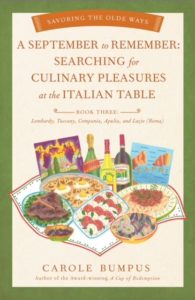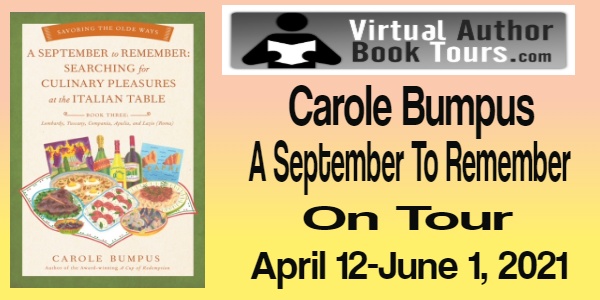
Description September To Remember by Carole Bumpus
This culinary travel memoir is an invitation to join in on a month-long trek through Italy, all in the search of the true Italian experience. Sprinkled with unforgettable characters, you will sup on sumptuous traditional foods, sip regional wines, and enjoy vast panoramas of extraordinary beauty. You may find yourself dancing at harvest festivals, climbing through Etruscan tombs, traipsing among Roman ruins, or bathing in ancient Roman termes (hot springs). You may also enjoy climbing to the heights of wonder in Capri or to the top of St. Peter’s Basilica. Or delight in soaking up the ancient and cultural history in Milan, Firenze (Florence), Amalfi, Pompeii, Lecce and Rome. You can bask in the sun and rugged beauty of the Tyrrhenian Sea, the Adriatic Sea, or the gorgeous Amalfi Coast. Or you can chat for hours over family meals while collecting a compendium of regional and traditional recipes (cucina povera), while you capture a rare glimpse inside the secrets to the Mediterranean psyche. It is truly a trip of a lifetime.Excerpt September To Remember by Carole Bumpus
Author's Note: [I’ve chosen this excerpt as it is close in context to the ancient Celtic culture, of which I also share an interest. My Irish mom’s interest in stories and history led my way. —Carole Bumpus]
CHAPTER SIX ETRUSCAN TOMBS OF SOVANA
The following day, my honey and I popped out of bed, excited to get an early start on exploring the Etruscan heritage. That day, we had pledged, we would visit the ancient tombs. We were so excited at the prospect of climbing into the ancient caverns, even though tales of vipers falling from trees had given us the willies. We were not snake people! We were soon on the road.
The sunlight diffusing softly through the cypress and oak trees, was like spun gold as it rose in dust motes into the air. Winston was clipping merrily along . . .. as we headed down the road of San Martino sul Fiora toward Sovana, another village known for a plethora of Etruscan finds.
“Sovana! Sorano! Sovana! Sorano! How do these people keep these names straight?” I babbled on as I tried to find my place in the new guidebook we had picked up the day before in Sorano.
“Ah, here we go. This says, ‘The Etruscan area surrounding Sovana has a special importance in respect to other centers of ancient Etruria in that all of the major types of funerary architecture of the Tyrrhenian region are found here.’ I wonder what that means? ‘The volcanic rock at Sovana was cut, chiseled and worked from the time of the earliest Etruscan settlements in the 8th century B.C. and their work continued throughout the entire ten centuries of Etruscan history and into the Roman period.’ Got that?” I asked.
Win nodded his head, but I wasn’t sure he had been listening. “So, where did you say the Etruscan people came from? We got some of this information at the museum yesterday, but I’m still not clear,” I said.
“Check in the section on Etruscan ‘Origins’, Winston gestured toward the book. I thumbed my way through to a page called “Origins” and read silently for a few seconds, then began aloud, “Around the fifth century B.C., the Greek historian Herodotus stated that some of the Etruscans may have emigrated from Lydia, a region on the western coast of ancient Turkey. It appears there was an 18-year famine in Lydia, so the king dispatched half the population to look for a better life elsewhere. Under the leadership of his son Tyrrhenus, the emigrating Lydians built ships, loaded all the stores they needed, and sailed from Smyrna (now the Turkish port of Izmir) until reaching Umbria in Italy.”
“It looks like,” Winston said, as he made a U-turn and headed back down another road, “these people, however they arrived, have been here since . . say, 900 B.C., but no one knows for certain where they came from. Like we learned yesterday, their prolific language is possibly from the island of Lemnos in the Aegean.”
“That’s right. I do remember,” I said. My husband shook his head but was busy trying to decipher a sign indicating where to park. Again, our Italian was lacking. “We will be seeing ‘chamber tombs, façade tombs, niche tombs,’ and, also your basic ‘burial ditches,’ I read from the book. “And also, rare and magnificent ‘temple tombs.’ Whoopee! This sounds positively grand,” I said, although a bit wary that these were all considered good things.
We were talking of death and dying here. We pulled into the parking lot that indicated the Illdebranda Tombs and stepped out onto a carpet of fallen oak leaves. Even though it was ten o’clock in the morning, ours was the only car in the parking lot. This was not Disneyland, but I had expected some crowds. I can’t say the silence was deadly, but it did feel a bit eerie. We put on our back packs and added water bottles.
“All right now,” Win asked, “what are we looking for again?” I could see my earlier narration had fallen on deaf ears—he had been driving—so I turned to the guidebook again, “‘You will find at the Illdebranda Tombs, rock-hewn tombs, necropoli, sacred pathways, wells, waterways—all hand cut out of the porous tufa stone. The burial chambers and the Etruscan temple from the Hellenic period of 3rd century B.C. were also carved with meticulous skill and without the use of mortar or bricks.’
Let’s take a look.” We were both surprised at the immensity of the beautifully carved temple. The façade had once rested on twelve fluted Doric columns. Only a few were left standing, but the detail remained indelible. I reached for the guidebook.
“‘The twelve columns probably alluded to the twelve towns of Etruria, and the capitals, which are now in a nearby museum, were decorated with the four faces of Etruscan divinities, both male and female, surrounded with large acanthus leaves. ”
Win took out his guidebook, as well, and read. “Etruscan temples were generally square buildings on top of a high stone plinth, with a large colonnaded portico to the front and a cella, or interior chamber, inside. The cella was often divided into three parts in accordance with the Etruscan belief in a triad of deities. . . .” We climbed the steps of “the high stone plinth” to the temple and walked under the once regal canopy of the yellowed tufa portico. We could still make out the concentric squares on the ceiling which, we had read, were representative of typical Etruscan temples.
But it was difficult to make out other designs, so I turned to the trusty guide. “It says, ‘The tympanum of the temple—the triangular pediment above the doorway—once had carved floral motifs in a complex mixture of flowers, leaves, bell-shaped flowers, and sacred animals. Along the cornice on the west side, the original sculpted frieze is still visible.’” What?
We rushed along to what we thought was the western side to see the details above us. Yes, we could make out a gryphon (a Greek mythological creature—half eagle/half lion), geese, the sun and other images probably related to the zodiac. The detail was amazing! Outdoors in the elements were images that had been etched into the rock between three to four thousand years ago! We could even make out the original details in the temple that had been plastered and painted in bright yellows and even deep reds. The colors remained. We were awash with amazement. The morning sun burnished the stones under our feet, as well as turned the air into a sweltering inferno. We hastened down the stairs to go below the temple, where we found two funerary corridors that led us out of the heat but into an almost frigid plane.
The main corridor, which was directly below the center of the temple, was a cross-shaped or cruciform burial chamber. It held a long single tufa funerary bed, indicating the temple had been dedicated to an especially important Etruscan. Royalty, of some kind. In the lateral corridors, we found more ‘beds’ that lined the walls for burials of members of the same family. It was difficult to grasp how important this feature must have been a millennia ago. And to imagine how many bodies had lined these walls. Claustrophobia set in. As we scrambled back out of the tomb, we spotted a sign by the side of the path for the Via Cava of Poggio Prisca.
“What is this cava we’re heading toward?” I asked.
“Another cave?” Looming ahead of us was an enormous passageway, or path, and not a cave at all. It appeared to have been painstakingly carved out of the solid tufa rock. Once again, we checked the guidebook. “Most walls of these Etruscan roads are cut out entirely by hand and are twenty-five meters (75 feet) in height with the path itself being around five hundred meters in length.’ Or 1,500 feet long,” Winston determined. He read on. “‘
The colossal work involved in opening these huge subterranean passages is incredible. High up on the walls are various incisions, often unreadable. Immediately beyond the entrance, high up on the left, Etruscan burial chambers can be seen.’” We walked forward to see what was visible. Yes, there were small indentations carved into the wall at a great height. He continued reading.
“These chambers were lived in by (Christian) hermits during medieval times and during the long and difficult period of Christianization. There are traces of a fresco of the Madonna and Child in a carved niche below.” We stood on our tiptoes, trying to keep our balance, as we stared straight up the mossy green sides of the ‘cava’.
“They’ve mentioned the Christian religion, but what about the Etruscan religions?” I asked. Always at the ready, Win turned to the section on religion and read. “Religion is a major contributor to the aura of mystery which surrounds Etruscan culture. The Etruscans believed in many gods, some of them adopted from the Greeks, and they also believed in malicious spirits: in particular, they worshipped the triad of Tinia, Uni and Minerva. . .”
“Ah, that trinity,” I laughed. “Should have known.” Win ignored my snarky comment and continued reading, “The walls of the Cavone are covered in signs and incisions made through the many centuries, including Christian crosses which served to exorcise the ancient pagan gods. In fact, the Cavone was at one time called the ‘Devil’s Road’ and was a source of superstition and fear. . .”
I’m not sure why, but we stepped a little more quickly up the pathway keeping our eyes moving both up and down, as the pathway was sometimes rutted with deep cuts made from what? Burial carts? This place was so quiet I could easily imagine a funeral procession plodding slowly along the passageway. I had read about the Etruscans’ use of human sacrifice and wondered if that would be mentioned. I encouraged my husband to read further. “
Roughly halfway along the passage next to another medieval niche is an Etruscan inscription of the IV-III century B.C. which reads VERTNE – probably a dedication to the supreme Etruscan god Vertumno or Veltha. Next to this inscription is an ancient swastika, a symbol of the Sun and polarity.” “Swastika?” Win asked.
“Ancient swastika,” I said. “The ancient swastika was a symbol used over four thousand years ago. It was Sanskrit and meant ‘well-being.’” We were now at the top of the passageway. We each took a deep breath, as, even though unspoken, we felt safe and sound. No mention of human sacrifice yet, but then we still had to retrace the path to retrieve our car. Rats! I opened the guidebook. Sure enough: “
A particularly macabre practice (of their religion) was that of human sacrifice to placate the gods and protect themselves from the kind of torment meted out by demons in the underworld which is depicted in their tomb paintings. Victims were forced to kill each other off in gladiatorial duels which took place at funerals.” Now, that was an event I would not have cared to witness. Oh, feet, don’t fail me now! Posthaste, we made a mad dash down the cavone (corridor) and back to our car.Author Note



















